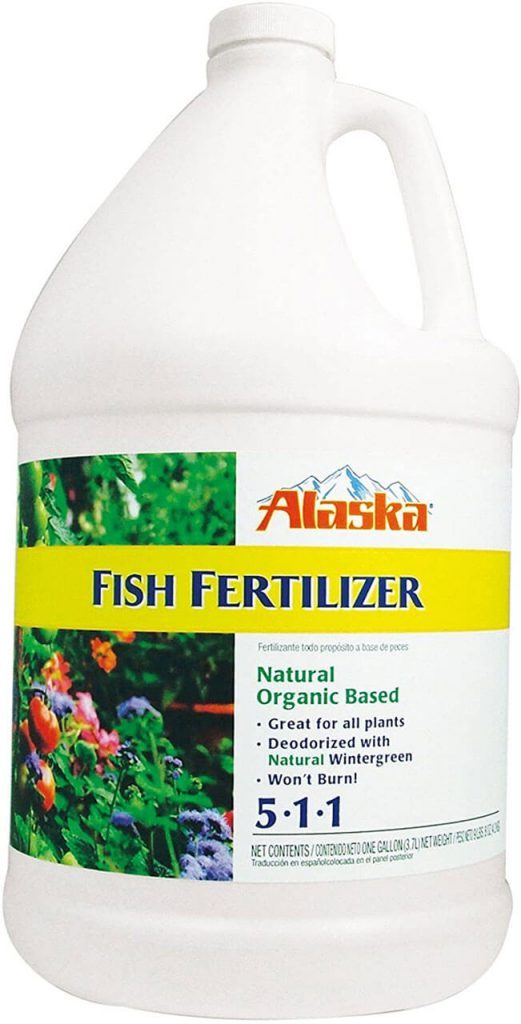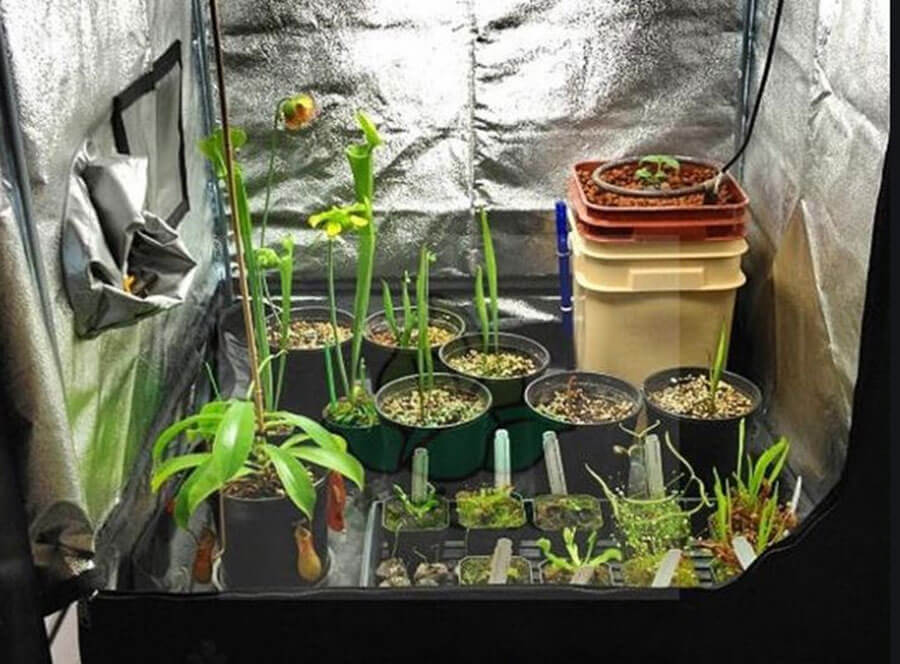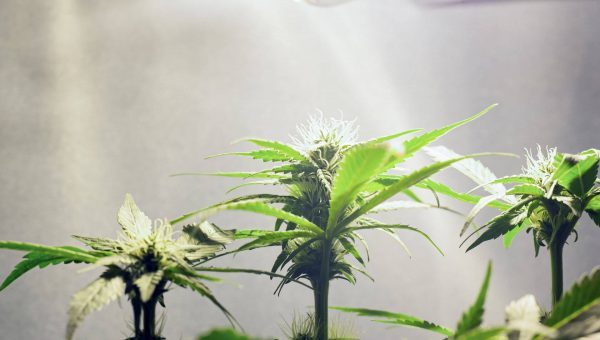When it comes to cannabis nutrient solutions, neem oil, bat guano, and liquid seaweed are some excellent examples of organic fertilizers. However, there’s a brand of organic fertilizer that stands out, and that’s Alaska Fish Fertilizer.
If this is your first time hearing about it, you might be wondering what Alaska Fish Fertilizer is and how it should be used for your cannabis plants. Read on to find out.

What is Alaska Fish Fertilizer?
Alaska Fish Fertilizer is a fish emulsion fertilizer manufactured by Lilly Miller. It’s a natural source of plant nutrition that’s derived from a blend of seagoing fish.
The numbers 5-1-1 on the container pertain to the N-P-K ratio, which indicates the levels of nitrogen, phosphorus, and potassium. It means that this fertilizer contains 5% nitrogen, 1% phosphorus, and 1% potassium, but it also has small amounts of other essential minerals like calcium, sulfur, sodium, and magnesium.
Fish fertilizer has a lower concentration of nutrients compared to traditionally processed fertilizers, so the nutrients are released into the soil more slowly and the effects last longer. Furthermore, if you’re an organic gardener, this fertilizer is OMRI Listed, meaning it’s suitable for organic production.
Nutrient profile
As mentioned earlier, Alaska Fish Fertilizer (5-1-1) has a nutrient ratio of 5% nitrogen, 1% phosphorus, and 1% potassium. Moreover, it contains essential minerals like sulfur, magnesium, calcium, and sodium.
Ingredients
The type of fish used in Alaska Fish Fertilizer is Menhaden Fish, which is a bony fish primarily found in the Gulf of Mexico and the Atlantic Ocean.
Pros and cons
Here are the pros and cons of using Alaska Fish Fertilizer:
- Easy to use by spraying
- An organic, slowly releasing plant food
- Pet and kid-friendly
- A rich source of fish nutrients to improve the power and vigor of your plants
- Can be used for both indoor and outdoor plants
- A very mild fertilizer, so you don’t have to worry about nutrient burn
- Has a long shelf-life, so you can keep it stored in a cool place for years
- Might attract flies initially until the smell disappears
- Should be kept away from your pets like cats or dogs
- Cannot be mixed with hydroponic systems
Note: Fish fertilizer can leave a strong fishy odor that can be unpleasant when the fertilizer is used on indoor plants. The aroma should dissipate in a day or two, but using the fertilizer outdoors can attract cats and dogs as well as raccoons and other uninvited guests.
However, the manufacturer of Alaska Fish Fertilizer 5-1-1 says that their product is nearly odorless and any remaining aroma won’t linger because it’s deodorized with wintergreen oil.
Modes of application
Once Alaska Fish Fertilizer is mixed with water, you can apply it using any convenient means of application. If you want to use this fish emulsion as a foliar spray and apply it directly to the leaves, you can use a pump sprayer set to give a fine spray or coarse drops.
You can also use a hose-end sprayer with a dial that you can set to dilute the product according to the label instructions. Using a small spray bottle also works well for indoor plants too.
If you want to apply this fertilizer to the soil or potting mix, use a bucket. However, a watering can is the easiest way to apply it evenly. Don’t forget to shake the container to keep the solution well-blended.
How does Alaska Fish Fertilizer work?
This fish fertilizer slowly releases nutrients into the soil. Though it may seem like a slow-acting fertilizer is a negative, it’s better than quick-release chemical fertilizers.
Another thing to keep in mind is before slow-acting fertilizer becomes beneficial for the plants, it should first be eaten and digested by microbes and other helpful organisms like worms, fungi, and bacteria. This results in a higher level of good soil microbes. These microbes and other microorganisms will break down the nutes. The breaking down of nutrients will make it easier to nourish the plant’s roots.
How do you use Alaska Fish Fertilizer?
The manufacturer recommends diluting this fertilizer concentrate by adding 2 to 4 tablespoons to each gallon of water. This can cover around 30 square feet of soil. You can apply it directly to the soil you wish to fertilize, or you can fill a spray bottle with the diluted mixture and use it as a foliar spray on the leaves of your plants.
As for the frequency of use, we suggest using this fertilizer on your plants every 2 weeks for best results. Its mild nature allows it to be applied more frequently than other fertilizers without causing harm to your plants.
Outdoor Plants
The rate of application of Alaska Fish Fertilizer 5-1-1 will vary depending on the type of plant. The manufacturer recommends a mixture of 2 to 4 tablespoons to 1 gallon of water. Diluted solutions of 3 tablespoons per gallon of water are advised for shrubs, berries, and perennials. Annuals, bulbs, and other veggies, on the other hand, will do well with a solution of 2 tablespoons of fish emulsion per gallon of water.
Meanwhile, root veggies will benefit from a more diluted mix of 1 tablespoon in 1 gallon of water. The same solution can be used for herbs and outdoor container plants. Use a weak solution of 1 teaspoon per gallon when transplanting bedding plants into the garden.
For your cannabis plant growing outdoors in a container, you can also apply this diluted fish emulsion every 3 to 4 weeks throughout the season, generally from spring to late summer.

Indoor Plants
Use a diluted solution of 1 teaspoon of Alaska Fish Fertilizer 5-1-1 per quart of water for a small indoor plant. You can increase it to 2 teaspoons per quart for a large plant. Feed your plant every 10 to 14 days during the vegetative stage.
Moreover, always water the plant immediately after feeding. Though fish emulsion is relatively mild, it can still burn sensitive plants.

Safety Measures
Since fish emulsion fertilizer is mild and breaks down slowly, it’s less likely to burn your plant’s leaves compared to chemical fertilizers. However, any fertilizer can damage plants. Make sure to follow the instructions by diluting it with water. Avoid fertilizing during hot afternoons or when the sun is directly on the plant.
Store the fertilizer in a cool, dry place and ensure that the container can’t be reached by children and pets. Ingesting fish emulsion can cause nausea, abdominal cramps, diarrhea, and vomiting.
Furthermore, use eye protection whenever you spray fish fertilizer because it can cause redness, irritation, and burning. Always wash your hands immediately after applying the fertilizer.
How do you make fish emulsion fertilizer at home?
If you want to save some money by making your own fish emulsion, you can. Some commercial fish emulsions lack the bacterial microorganisms that are important for soil and plant health. But if you have fish scraps available, you can try to make your version of fish fertilizer that contains these microorganisms.
The procedure outlined below can yield around 2 liters of concentrated fish emulsion from 2 kilograms of fish scraps. Note that it can take a month to decompose sufficiently and extract the fish emulsion for that amount. You can make it go faster by using fewer fish scraps, but obviously, it will yield a smaller amount of fish emulsion.
After extracting the fish emulsion, the pulp that’s left behind shouldn’t be wasted. It can be used as a starter mix for the next batch of fish emulsion due to its state of decomposition. You can also use it to feed your compost pile so that you can mix it into your garden soil later.
Remember that you shouldn’t use the extracted fish emulsion directly on your plants. You must always dilute it first before using it as fertilizer.
Things you’ll need
- 2 kg of raw fish scraps
- 1 cup of molasses
- 2 pounds of sawdust
- 5-gallon plastic bucket with cover
- Window screen
- Spatula or garden hand rake
Procedure
- Pour an inch-high layer of sawdust into the 5-gallon bucket. This will absorb the extra nitrogen expelled by the decomposing fish. You can also add dried leaves or grass clippings if you wish.
- Pour all the fish scraps into the bucket, but make sure to remove the excess water first. Then, add 2 tablespoons of molasses. The molasses will feed the microbes that will decompose the fish parts eventually. The sweet sugary smell of the molasses won’t get rid of the smell of rotting fish, but it will mask it a little.
- Mix the fish scraps, molasses, and sawdust thoroughly using a spatula. It might be a bit difficult to mix it all because the fish scraps are semi-solid.
- After mixing everything thoroughly, sprinkle a thin layer of sawdust on top and spread it evenly. If the sawdust absorbs the water from the mixture and becomes wet, you should continue adding more layers of sawdust until the topmost layer stays dry.
- Cover the bucket with a piece of window screen. Ensure that it covers the bucket’s opening and still has a couple of extra inches beyond the rim. The window screen will help prevent flies from going inside the bucket.
- Don’t open the bucket at all during the daytime for the next two weeks. If you need to open the bucket, do it only at night.
- For the next four weeks, open the bucket every other day to mix and aerate the contents. This aeration will prevent the buildup of anaerobic bacteria that mainly contributes to the foul smell.
- Continue adding 2 tablespoons of molasses as needed to control the odor and aid in the decomposition of the fish scraps. Fish bones, heads, fins, and tails take longer to decompose, so give them at least a month. Afterward, you can extract and collect the fish emulsion.
FAQs
What is Alaska Fish Fertilizer good for?
Alaska Fish Fertilizer is a rich source of organic matter that releases and breaks down nutrients in the soil to enhance the strength and vigor of your plants. In addition, it contains naturally occurring soil microbes that can thrive in soil that’s rich in organic matter.
How often should you use fish fertilizer?
To get the most out of your fish fertilizer, apply the mixture twice per week.
Can Alaska Fish Fertilizer burn plants?
Alaska Fish Fertilizer is mild and won’t burn your plants.
Does fish fertilizer attract rats?
Fish emulsions are known to stink, but Alaska Fish Fertilizer is a deodorized version. It may attract some rats initially, but the smell is not as offensive as other fish fertilizers.
How long does fish fertilizer last?
If the temperature is consistent at around 70 degrees Fahrenheit and the product is kept away from direct sunlight, Alaska Fish Fertilizer can usually remain stable for up to 5 years or longer.
Is Alaska Fish Fertilizer recommended for your cannabis plant?
All plants, including marijuana, require nitrogen, potassium, and phosphorus. Alaska Fish Fertilizer can provide all of these nutrients, so it will definitely work as well on a cannabis plant just like any other plant.
Final Thoughts
Alaska Fish Fertilizer is a blessing for organic marijuana growers and other gardeners. It presents a lower risk of nutrient burn because it releases nutrients slowly. Though the smell is noticeable at first, it will dissipate over time. If you’re interested in this fertilizer, we strongly recommend it because it’s been proven to work. Your plants are sure to benefit from it.


